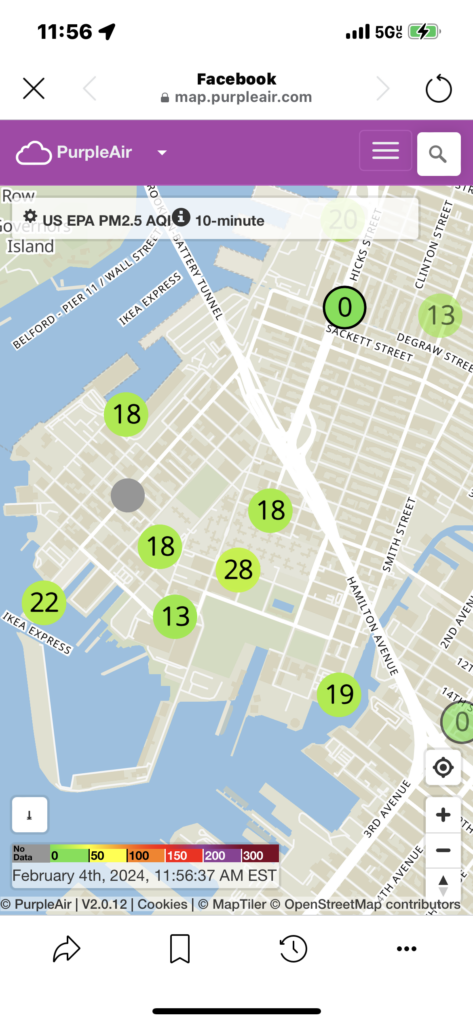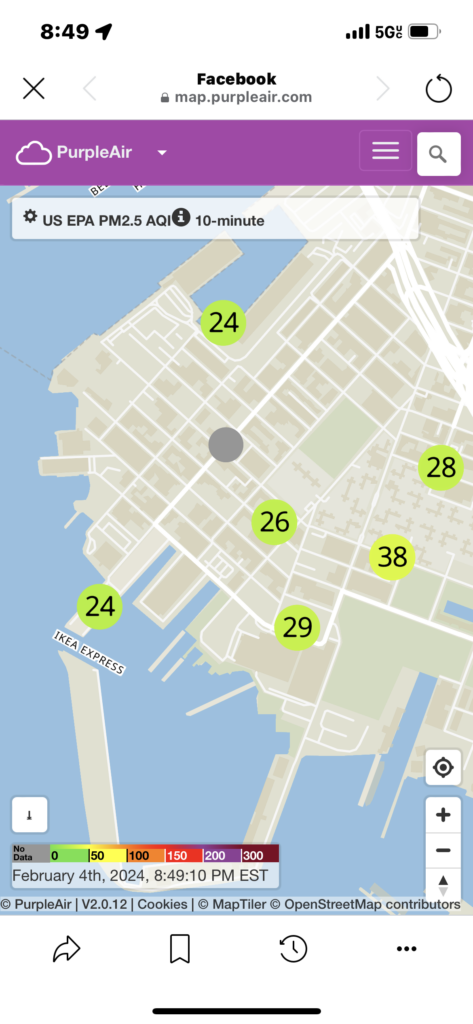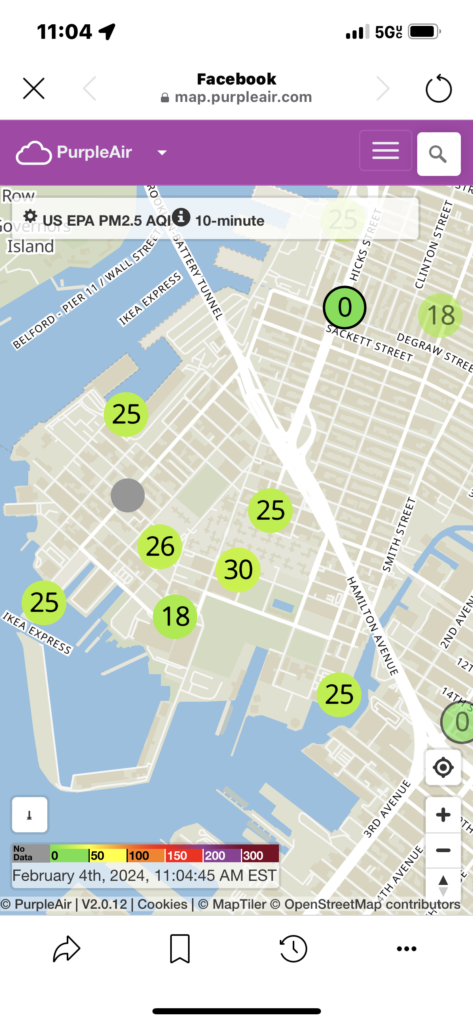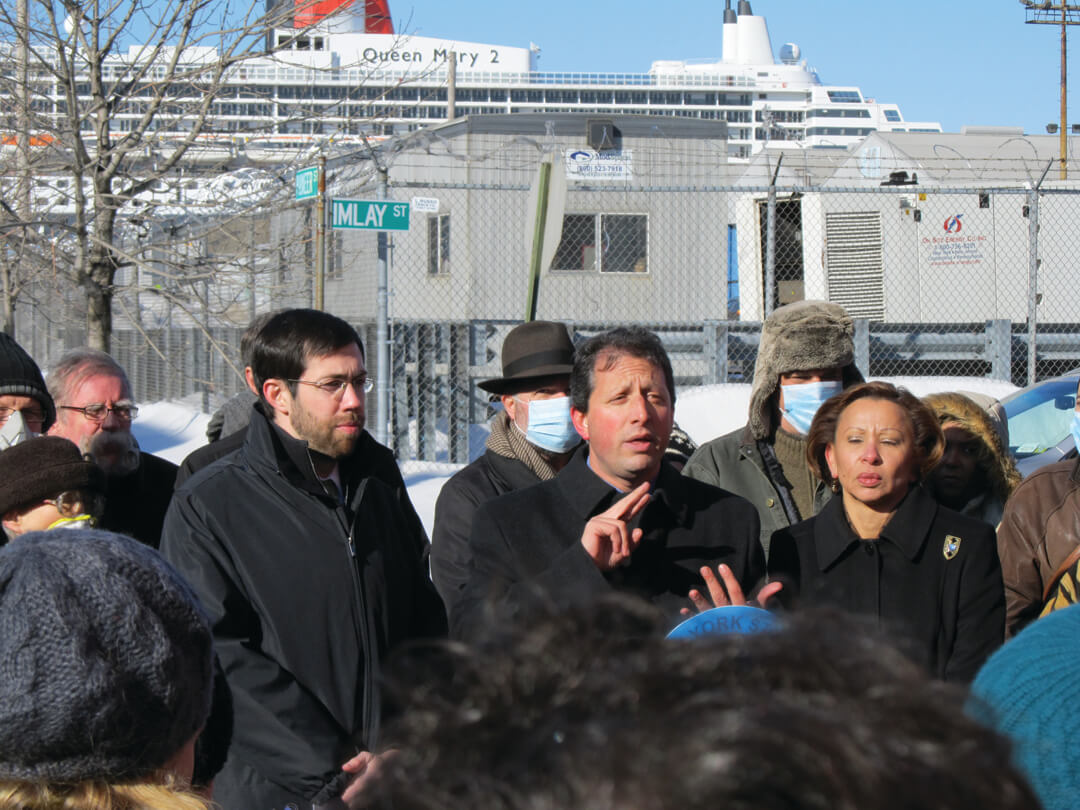Back when I started the paper, in 2010, Red Hook resident Adam Armstrong began his mission to bring shore power here. This is a way to power berthed cruise ships with electricity rather than the fossil fuel they burn at sea.
Twenty million dollars later, a rarely used shore power apparatus was built on the pier. Armstrong was able to get all the politicians you see in the photo on this page on board to raise the money, because ecology is a vote getter.
I asked Armstrong whether there had been a scientific study done to make sure the money was well spent, and he looked at me as if I were an idiot, telling me that “everybody knows” that ships cause pollution, and lots of people in Red Hook have asthma. I pressed the issue, probably because I’m a graduate of Bronx Science, and he told me a measuring device would be too expensive, and besides, they’ve done studies in Oakland that prove it. I’ve been there, and they have lots more ships than we do.
Last month the email newsletter for the Red Hook Initiative proudly announced that they were now monitoring Red Hook air. They won a grant to install air pollution monitors throughout the neighborhood. It turns out the PurpleAir monitor they use only costs only $300! RHI invited everybody to monitor pollution in real time. They even gave the website URL, which is https://bit.ly/482zEUe
So now you can monitor the air yourself. I have been, and it seems that Red Hook air quality echoes the air quality in the region, sometimes bad, often good, probably depending on the weather.
From now on the Star-Revue will be tracking air whenever a cruise ship is in town, which seems to be every Sunday (https://nycruise.com/brooklyn-terminal/schedule-bct/).


I took readings on Feb 4, which are reproduced above. I’ll report again next month.
Author
-
Founder and editor of the Red Hook Star-Revue. George is also a musician and one-time progressive rock disk jockey, in York, Pennsylvania, also birthplace of Mrs. Don Imus.
View all posts
Founder and editor of the Red Hook Star-Revue. George is also a musician and one-time progressive rock disk jockey, in York, Pennsylvania, also birthplace of Mrs. Don Imus.










One Comment
Hi George,
I beleive my name was invoked. I hope you allow your readers to see my reply.
I started my letter/email writing campaign in 2005, when the City said it was building a cruise terminal at the end of my young family’s street without any plan to mitigate the pollution that would soon be created by the visiting cruise ships. This in a neighborhood with already high asthma rates, home to the largest public housing complex in Brooklyn, full of truck heavy businesses, and a working container port. I thought it was unfair to impose another source of air pollution – from huge idling cruise ships – when there was an alternative. Shore power.
The terminal opened in 2006, and I continued to write emails, attend community meetings, NYCEDC meetings, and even Port Authority hearings, urging for the investment in shore power, a technology that the US Navy had used for 50 years, and in which West Coast ports had already begun to invest – for container ships and cruise ships. In fact, the first U.S. cruise terminal to invest in shore power for cruise ships was Juneau, Alaska, in 2001.
In 2009, when the Port Authority announced that they would be investing in zero-emissions shore power at the Brooklyn Cruise Terminal, one of the hurdles to making the system viable and attractive to the cruise companies was the cost of the electricity that ships would have to use. As a result, a case was opened at the Public Service Commission, requesting the creation of a shore power tariff – a special rate of electricity supply that would be created to be used by ships. This rate would apply to any ship using shore power, including (theoretically) container ships that would be offered shore power if it were built at the city’s cargo ports, and elsewhere in New York State (I believe).
In testimony to the Public Service Commission in support if the creation of a shore power tariff to incentivize the investment in shore power, Region 2 EPA offered comments, as follows. (Link for the document here – https://drive.google.com/file/d/1Mv1LjhM7aI4hp2vpvONEQ6eHyFkidudj/view?usp=sharing )
“Region 2 of the United States Environmental Protection Agency (EPA) is not an active party.
However, it filed comments in support of a Shore Power Tariff
EPA comments as follows:
a. Shore power is a crucial step for cleaning our air
and improving the health of New Yorkers.
b. Ocean-going vessels that dock in New York City
typically burn high sulfur fuel in diesel engines to generate auxiliary power. This combustion results in exhaust containing NOx, SOx, and particulates and such exhaust is likely a carcinogen. A Port Authority study shows that use of Shore Power at the Brooklyn Cruise Terminal would annually eliminate 100 tons of NOx, 100 tons of SOx, and 6 tons of particulates.
c. New York City’s air quality is among the worst in
the nation and port-related air emissions are
meaningful and avoidable.
d. Such air emissions are harmful to the public
generally, and especially to children, the elderly, people with lung diseases, those who exercise outside, and low-income and minority communities located near ports.
e. Implementation of a Shore Power Tariff is consistent
with economic development in New York City.
f. Implementation of an appropriate Shore Power Tariff
in New York City would provide an impetus for ship owners to invest in ship-side Shore Power equipment and for widespread use of this technology in other ports on the east coast. ”
These comments from the EPA have lived permanently on the sidebar of my now dormant blog, which I began in 2009 in order to share information about this subject, and other Red Hook issues. These are the facts and statistics that have driven me on this nearly two decade long “mission”, as you called it.
I’ve only ever shared information and quotes from experts and scientific sources. I’m surprised that you’ve decided to make derogatory remarks about me, because this has never been about me. It’s been about advocating for a very obvious solution to the problem of ship pollution in Red Hook.
By the way, the politicians you point to above were having that rally in 2011 to urge the City to resolve the issue of the cost of electricity for shore power. The shore power system had already been committed to in 2009. But it was somewhat stalled by the inaction of the Public Service Commission. The pols were urging it to move forward. Here’s a story on it – https://www.brooklynpaper.com/pols-city-needs-to-cruise-on-green-solution-to-pier-pollution/
It was the Bloomberg Administration that finally pushed the ball forward on shore power, making a deal to do so in 2011. According to the 2019 New York TImes story on cruise ship pollution in Red Hook (you’ve read it, I’m sure), the Bloomberg Admin had done a study in 2009 which found correlation between high levels of PM2.5 in NYC communities and Vanadium, a heavy metal only found in ship emissions. That study apparently compelled Bloomberg to make the deal happen with the cruise companies, NYCEDC, EPA, and NYPA – with all pledging investments in shore power in Brooklyn, and the cruise companies pledging to retrofit any ships that weren’t shore power compatible. Here’s a link to that study – https://drive.google.com/file/d/132Cal_6biYsKnRF7O3jjU9X8kaCj83nAZVJkWaLna_4koCDb0iYTW2xxICyJXGh0Z6VwoOTkf94ONTCS/view?usp=drive_link
Regarding your recollection about me saying to you that air monitoring was “too expensive”. I do not remember saying that. I certainly don’t think its a waste of money. I do think it’s unfair to expect individuals or communities to be forced to be monitors of their own air, because the City doesn’t do it. As I said in our recent Twitter exchange, “asking every neighborhood to provide its own air quality data is onerous. If a cigarette smoke kills kids in LA, you don’t need to prove that it kills kids in NY. Same goes for ship pollution”. This exchange between you and me occurred in the comments to this Tweet from BP Reynoso, if you need a refresh – https://x.com/BKBPReynoso/status/1703893064870195659?s=20
If I looked at you 15 years ago, as you said, “as if (you) were an idiot”, because you were asking for scientific evidence, I don’t believe I’ve ever treated you disrespectfully – definitely never “in print” in my blog. If I said “everyone knows” that ships cause pollution, maybe it’s because I had been learning a lot about it at the time -via my own research and conversations with experts like John Kaltenstein who works on ship pollution matters at Friends of The Earth. I do remember having an animated conversation with you, George, on Van Brunt Street around the time the shore power system was was being planned. It was right before I was about to play a daytime outdoor gig. My recollection is that you were asserting that you didn’t think that ships idled in port – or that some didn’t. If my response that they certainly did (it’s called hoteling) – and still do throughout the Ports of NY and NJ – offended you, I’m not sure why. Many people do not know this, and that was part of my reason to start a blog. To share information about the impacts of cruise and ship pollution that didn’t seem to be widely known in Red Hook and our city in general – and solutions to the problem. But surely you agree now that ships shouldn’t be idling in port, when there is an alternative – shore power. That’s why ports around the world and the country are investing in shore power. To take the burden of idling ships off port communities, and to eliminate the burning of 100+ gallons an hour of dirty fossil fuels. In fact, instead of the ships buying fuel from multinational oil companies, they purchase electricity from local utilities. Europe has a regulation now that every maritime port needs to offer shore power by 2030. It’s a shame that our Ports of NY & NJ haven’t made the same investments in shore power and decarbonization over the last decades. The Port of NY & NJ is the busiest port in the United States, behind the Ports of LA and Long Beach, which have widespread shore power infrastructure, for cruise and container ships – which is mandated. There are penalties if ships don’t plug in.
I understand your skepticism about the money spent on building the system in Brooklyn, when it has been woefully underused. The Port Authority, EPA (via a diesel emissions reduction (DERA) grant, New York Power Authority, and NYCEDC all have investments in Brooklyn’s system. But the planning and execution of the shore power system by NYCEDC has been a big problem – using a connection system (jib) that can’t connect to many of the ships using the terminal. Shore power capable and compatible ships are now connecting to the system 70% of the time, according to EDC. The MSC Meraviglia cannot connect until updates to the system are made. EDC says that will happen by end of 2024. (not holding my breath) But another big loophole, is there is no mechanism to enforce the use of shore power, and ships have too often not plugged in. That’s what Council-member Aviles’ proposed legislation, “Our Air, Our Water Act”, hopes to address. Your paper has covered the debate about this bill with excellent reporting from Brian Abate. This bill will ensure that every ship connects to the shore power system, every time. That will be a good return on the investment, for public health, and the planet. In fact, in EDC’s 2016 press release saying that shore power was “fully operational”(it wasn’t!) , but the EDC press release states: “The health benefits associated with improved air quality (from the use of shore power) will generate approximately $99 million in cumulative savings over 15 years”. The fact the shore power is supplied by 70% hydro-electric generated NYPA electricity, means that the system is pretty close to zero-emissions, providing huge reductions in SOx, NOx, PM2.5 and CO2, compared to ships running auxiliary engines. That’s good for human health and the climate.
The EPA’s “Shore Power Emissions Calculator” can provide good data on these reductions, for any ship using shore power anywhere in the U.S. https://www.epa.gov/ports-initiative/shore-power-technology-assessment-us-ports
I hope you do come around to be less contrarian about the investment in shore power in Red Hook. It did shock me to read your negative personal characterizations of me and my supposed powers of persuasion over politicians. I’m not sure what you think I’ve been getting out of this after all these years. I certainly haven’t benefited from it financially or otherwise. My family and I left our home in Red Hook partially because of frustrations about the state of affairs with shore power. I’m still worried that my kids breathed that ship pollution for 15 years. I have received nothing financially from this “mission”. I have spent countless unpaid hours writing, serving on committees, going to meetings, hearings, and the rest. It’s been a lot. But, I am still passionate about this issue, and will continue to advocate for shore power, and anything that will help to decarbonize our ports and lift the health and climate burden of ship and port pollution from our communities.
Maybe you’ll do me the courtesy of printing my response here in the next edition of the Red Hook Star Review? I doubt many will read this long response on-line, but I do know that people in Red Hook read your paper, and now have read your negative portrayal of me and my activism in print. Perhaps you’ll give them a chance to read my words too.
Regards,
Adam Armstrong